#pea + wheat apparently...
Explore tagged Tumblr posts
Text
nando's has really just quietly pulled off a shockingly good vegan chick'n product eh
#m#idk what I was expecting 'the great pretender' to be I guess just some generic thing?#but it is very much like the non-nasty parts of chicken#and afaict nobody really noticed its existence? lol#pea + wheat apparently...#food#I guess this is really just for the hypothetical australians in the audience lol
3 notes
·
View notes
Text
here's one that's even more bonkers that I didn't report on. it involves writers over at Haaretz being very incompetent.
on the age of chickpea cultivation in Palestine, people variously say 10,000 BC, 8400 BC, 8000 BC, 7000 BC &c. as if at random.
foodtimeline.org (which supposedly provides sources to the researcher but has betrayed me many, many times) cites: Food in the Ancient World From A to Z, Andrew Dalby [Routledge: London] 2003 (p. 84).
Dalby says:
Chickpea, one of the oldest cultivated pulses in the Near East. Chickpeas were grown in Palestine by 8000 BC.
this book is actually useless from a research perspective and belongs to what I like to call the "just some guy saying something" approach to making claims. none of the works cited at the end of the page on chickpeas (yes! none of the claims are associated with a particular work! there are no footnotes! so if you want to trace a particular claim, you've gotta look in each work mentioned! lol!) are scholarly works either, all of them also belong to the "some guy saying something" school of thought, and, most dizzyingly, none of them contain the 8000 BC claim!
okay, let's take another tack. wikipedia says:
"The earliest well-preserved archaeobotanical evidence of chickpea outside its wild progenitor's natural distribution area comes from the site of Tell el-Kerkh, in modern Syria, dating back to the early Pre-Pottery Neolithic period around (c.8400BCE). [12]"
[12] turns out to be an article titled "The Strange Origin Story of the Chickpea" on Haaretz (ugh), which is hardly a scholarly source, but perhaps it cites one! Haaretz says:
The question addressed in a new paper published in May in the journal of Molecular Biology and Evolution is historic: how the domestic chickpea arose and spread, first apparently to the Middle East – signs of chickpea domestication were identified in el-Kerkh, Syria, that may be as old as the 10th millennium B.C.E. – and onwards, the western Mediterranean and to Asia, and to eastern Africa (specifically, Ethiopia).
the particularly sharp-eyed among you may notice that "10th millennium BC" (10,000 to 9,001 BC) is a different claim from "8400 BC," but, oh well, let's click that link.
it's a paper titled "Historical Routes for Diversification of Domesticated Chickpea Inferred from Landrace Genomics." it contains no references to the finds in el-Kerkh, or to a 10th millennium BC claim, or a 9th century BC (which the year 8400 belongs to) claim; it's more about developing a model to trace spread, rather than attesting evidence for any particular date. the author of this article must have just added the information about the site in Syria from, idk, their own background knowledge? lol.
but let's keep pushing this. elsewhere in the same article, a paper titled "Draft genome sequence of Cicer reticulatum L., the wild progenitor of chickpea provides a resource for agronomic trait improvement" is linked. this paper contains in its introduction the claim:
Chickpea was domesticated with wheat, barley, peas and lentil as a member of West Asian Neolithic crops during the origin of agriculture around 10,000 years ago with the oldest archaeological evidence from 7500 B.C.4,5
also a very different claim from both "8400" and "10th millennium BC", but okay, let's try to trace this one.
citation 4 is a paper titled "Evolution of cultivated chickpea: four bottlenecks limit diversity and constrain adaptation," and it also has to do with something completely different from archaeological evidence for chickpea cultivation. in reference to the claim it is cited to support, it contains only the sentence:
Chickpea is [...] associated with the origin of agriculture in the Fertile Crescent some 10000 years ago.
for this rather vague claim, they themselves cite two other sources: 2000, Lev-Yadun et al. "The cradle of agriculture," Science 288, 1602-1603; and 1999, Zohary D, Hoph M "Monophyletic vs. polyphyletic origin of the crops on which agriculture was founded in the Near East," Genetic Resources and Crop Evolution 46, 133-142.
citation 5 is Harlan J. R. 1971, "Agricultural origins: centers and noncenters," Science, 174, 468–474. this one says, summarizing other research, that in the "Near East" (bleucgh)
barley, einkorn, emmer, peas, lentils, flax, vetch, and chickpeas appear to have been domesticated, together with sheep, goats, pigs, and possibly cattle.
the source for this sentence is G. Wright and A. Gordus, Amler. J. Archaeol. 73, 75 (1969).
okay, well, this is starting to get obviously silly; trying to trace these claims further and further back until a primary report of an actual archaeology site is found is clearly pointless, especially since at this rate the find would be from like 1954 and almost certainly new evidence has come to light since then.
let's try something else. despite the fact that Haaretz's "signs of chickpea domestication were identified in el-Kerkh, Syria, that may be as old as the 10th millennium B.C.E" claim didn't actually come from the source that they cited, surely it must have come from somewhere?
I find two papers describing the finds in el-Kerkh, written by the same team. "The origins of cultivation of Cicer arietinum L. and Vicia faba L.: early finds from Tell el-Kerkh, north-west Syria, late 10th millennium B.P." is the one that deals specifically with the chickpea findings.
aha! here, perhaps, is the source of the "10th millennium BC" claim! I suspect someone misread the title of this article, and read nothing else!!
the trouble is twofold: 1. "10th millennium BP" is given as the age of the site, not specifically of the cultivated chickpeas that were found; and 2:
"BP" is not "BC"!!!
"BP" is a metric of time used in carbon dating. it means "before present." the "present" is set to the year 1950, since this is close to when carbon dating was introduced. 10,000 years before 1950 is 8050 BC, and this is the absolute oldest date allowable based on just the title of the paper.
however, if we actually read the paper (or, I mean, skim it for a date, lol), we finally find something concerned with dating a particular site rather than making a genetic model; still better, we find this beautiful, readily comprehensible table shewing us "Archaeobotanical records for C. arietinum [...] in the early Neolithic periods", citing a specific site, the number of beans found there, the estimated date BP of those beans based on carbon dating, and a reference to the paper that details each find:

the "this paper" reference based on the Tell el-Kerkh site gives the date
9350-9165 B.P.! that's 7400-7215 BC! we have a date range at last!
other papers in this chart give estimates that are more recent (e.g. 9320 - 9175 BP), based on papers from the 80s and 90s.
so, if this paper is more recent that any other citation I found during this whole journey (2006), and it claims to have pushed the date on the earliest piece of archaeological evidence for cultivation of the chickpea back (note that archaeological is different than evidence based on literature, genetics, &c.), then where on earth are "8000 BC" and "8400 BC" coming from? I still don't know.
tl;dr: a lot of people say that wikipedia, research blogs online, popular news publications, and things of that ilk are not sources on their own, but that they can be a good starting point to help you find sources. I no longer believe that to be the case. you are better off just starting in jstor or google scholar &c. and ignoring everything else. the claims you find in the latter way may, however, still be wild goose chases even if they are published in scholarly journals. the citation webs in academic journals are dizzying and people rarely trace a claim back to its actual origin, instead content to cite a source that cites a source that cites a source that cites a source........
anyway. I share my humble stories simply for entertainment purposes only.
48 notes
·
View notes
Text
I am about to make an entire ethnic group mad at me. Ready? Here goes.

Southerners don't know how to make biscuits.
Please note, I am not saying they are unable to make biscuits. They make perfectly good, even exceptional, biscuits. (Note, I am talking about the American usage of "biscuit", not the British term)
But Southerners have no idea HOW they are making good biscuits. They are doing what their mama or gramma taught them, using very possibly the exact same tools, buying ingredients from the same grocery store, and reproducing the same results, but this is not a skill they have any capacity to explain.
And if you look online, you can find a plethora of Southerners who moved (invariably to New York City, apparently) and suddenly were completely unable to make decent biscuits, with no ability to diagnose why. Once they have made a clean break from their traditional tools and materials, they are lost.
Which means you end up with all these weird essays as they flail around and make up reasons for why "Northerners" can't make good biscuits, usually inventing super special secret ingredients, which they then share.
None of these Southern-led instructions work. If anything, the results are worse. If you want to know how to make good biscuits: find a Northerner who has learned and ask them. That is, find someone who learned as an outsider, because they will be able to explain what they're actually doing with awareness, not simply "and then you do like gramama did which is, uh, you just do!"
None of the instructions I've seen from Southerners on the art of biscuit-making work. By contrast, the recipe in Joy of Cooking has never failed me.
Here is what I, as a Northerner, have learned. Let's start with the recipe:
2 cups all-purpose flour
2 tsp baking powder
1/2 tsp baking soda
1 tsp salt
6 tbsp butter
3/4 cups buttermilk
1. Preheat your oven to 450°F. Thoroughly clean a space on your counter to roll out your biscuits.
2. Combine the dry ingredients in a large bowl. If possible use a sifter.
3. Using a pastry cutter, cut the butter into flour. You do not want to cut it too much - stop shortly after you get it down to pea-sized bits.
4. Add all the buttermilk at once. Combine with a rubber spatula or wooden spoon until it's combined enough to work by hand. Then, once you can work by hand, knead together very firmly. (I will note more on this step later, it's important but people make it Weird.)
5. Roll the dough out to a thickness of about an inch. If you have a biscuit cutter use that to cut the biscuits, otherwise use the bottom of a glass and a paring knife. Gently knead the excess dough back together and cut more biscuits until you run out of dough. The fewer times you have to knead the dough, the better off you are.
6. Arrange the biscuits on a baking sheet. Brush the tops with milk or melted butter and bake for 10-12 minutes.
Now, this is not a terribly complicated recipe. And, start to finish, it will take roughly half an hour, mostly due to the time it takes to heat the oven to 450°F. So here are the important things I have learned:
a. DO NOT use self-rising (or raising) flour!!!!!! Ever!!!! Yes, I know that's what your gramma used, but she was using a particular brand in a particular region with leavening adjusted based on decades of experience. Self-rising flour is a terrible scam and makes people think they suck at baking. All it is, is all-purpose flour with some unknown amount of unknown leavening and maybe salt added. How much? No idea! They certainly aren't going to tell you. It takes control out of your hands. Use unleavened all-purpose flour and measure your own damned baking powder, baking soda, and salt.
b. You do not need a special soft wheat flour which is only sold in 50-lb bags under the full moon at a mill in rural Kentucky. If that was important, that kind of flour would be in every grocery store in the country. Any all-purpose flour will work. It's possible that you might get some interesting results mixing in a lower-gluten cake flour, but odds are you personally will see no value in that kind of fussiness, and it's certainly not necessary for good biscuits.
c. By contrast, the buttermilk does matter. It's not impossible to make good biscuits using standard grocery store buttermilk, but you will thank yourself for finding a nice, rich buttermilk from a local dairy.
d. Now, the kneading. This is the big one. Biscuits are in fact an awful lot like pie crusts. And like pie crusts if you work them too much they will get awful and tough. The problem here is that most online guides make you terrified of working the dough at all, and you spend 45 minutes poking tentatively at the dough with icy fingertips, which is 45 minutes wasted because that will never get the dough to come together and you're still going to need to do actual kneading. I honestly think this is why people end up with hockey pucks: they lack confidence and end up doing far worse than if they'd jumped in and just done it. So....
First, as with any dough, it's going to be very sticky when you first add the liquid. You will not be able to knead it at this stage. You need to use the aforementioned spatula or spoon to fold the liquid in until it's no longer too sticky to knead - and only until that stage.
Second, once it's no longer too sticky to work with, you're going to need to get your fingies dirty. Make sure your hands are CLEAN and DRY. If you did this in a big enough bowl you can knead directly in the bowl, otherwise you'll need to turn it onto the counter.
Third, use a lot of pressure. This is not a "tickle lightly with iced fingertips" situation. PUSH THAT DOUGH. Your goal is to force it together. Quickly. You should be able to do this in two or three turns because you are kneading it like it's the neck of the worst boss you've ever had. The one who called you in to run the register on Xmas eve so they could go home and watch TV. If the dough were their skull, it should be crushed. Use a lot of pressure very briefly. but VERY briefly. Put your weight into it; your goal is to press the whole mass together right away and be done.
Fourth, apply that same approach to rolling it out: fast, forceful, confident.
It's a simple thing, but there are many ways to screw it up. The trick is in knowing what they really are.
5 notes
·
View notes
Text
Day 3 Mon. May 29 Baker City, Oregon to Twin Falls and Idaho Falls, Idaho 700 km
What's become clear is that in order to hit my destinations, I am not going to be able to entirely avoid the Interstates. Case in point, in order to make my 700 km today, I had to take Interstate 84 to Twin Falls. At 80 kph, you don't get much local flavour, and you're certainly not stopping to take pictures. However, you can gather impressions. When I think of Idaho, now I will think of wind turbines, solar farms, transmission lines, irrigation and cattle, cattle, and cattle. I'll also think of the Oregon Trail, which stretches from Missouri to Oregon and 500 miles through Idaho. And always in the distance, scenic mountain ranges, some snow capped, and all sporting fluffy white cloud banks overhead. Without irrigation, it can get pretty brown, but with it, Idaho grows impressive amounts of potatoes, wheat, barley, hay, sugar beets, peas and lentils.





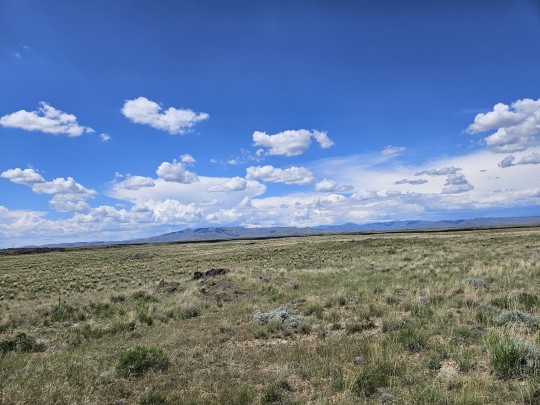


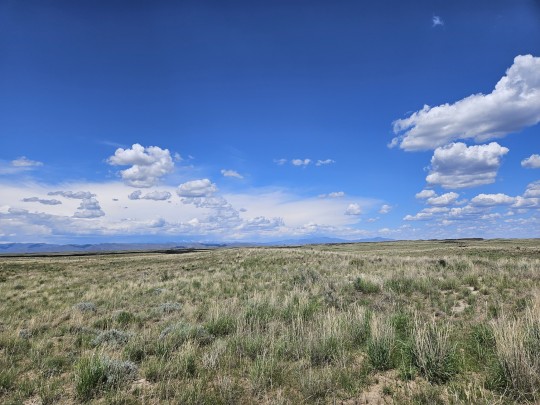
Of the two cities I visited, Twin Falls has a pop of 53,000, Elev. 3,734 ft and is known as the gateway to the Snake River. At its east end, there's Shoshone Falls and at its north Penine Coulee Falls.
Idaho Falls is a city of 66,000, Elev 4,705 ft, and is the commercial, cultural, and healthcare center for eastern Idaho, western Wyoming, and Southern Montana.
I took the scenic route between the two along US 26 and US 20, which took me past the Craters of the Moon, a 600 sq mile lava field that is still regarded as active and likely to erupt again.
I also passed through Arco, apparently the first town in the world to be lighted by atomic power (1955) by the nearby atomic reactors of the 900 square mile Idaho National Laboratory nuclear testing and storage facility. It also sits beneath a mountain covered in the numbers of its graduating classes.
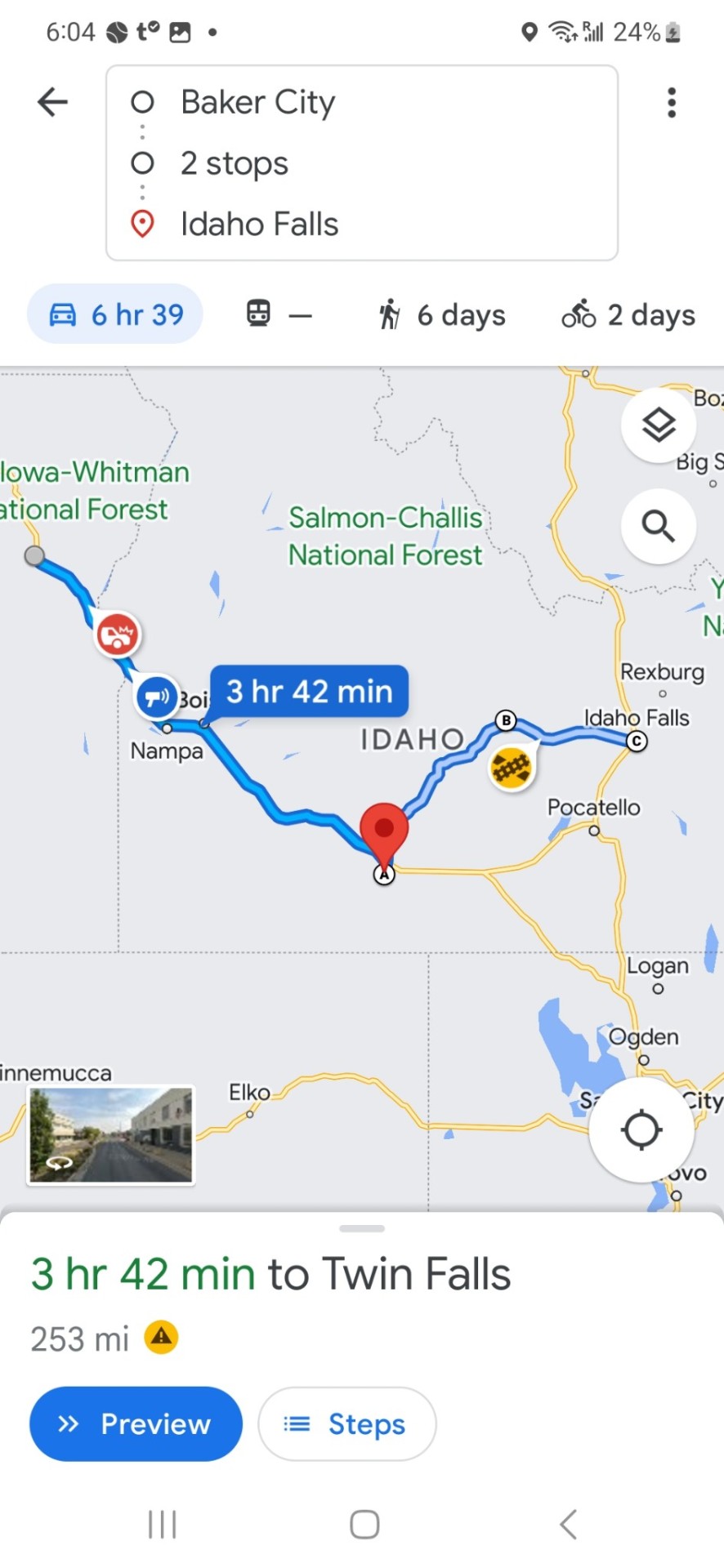
1 note
·
View note
Text
Daily Foods I eat
My goal are to have a 10-15% body fat, anti-aging regimen, and be physically fit.
Below are foods/supplements I eat every day to for my goals :P health.
I am increasing my protein intake mostly for weight loss and muscle building, so that's the vibe rn.
FOODS + Reasons
300g Greek Yogurt
Satiating
high protein
Good for digestion
Apparently the probiotic can help with micro/nanoplastic toxicity (this is new research so there needs to be an RCT but it look interesting
2 servings Vegan protein powder
I do 1 serving of the Owyn chocolate sugar free which is the best I've tried, its a bit more expensive than Orgain but honestly its so worth it
And 1 serving of the Myprotein vegan tiramisu flavor and it tastes kinda good
I usually do it with water, but with really good with unsweet soymilk
this gets me 50g of protein
Both are made with pea and pumpkin protein so its a full and digestable protein. I have nothing against soy protein but I already eat lots of TVP and tofu, and too much soy can potentially be bad
Fiber supplement with a mix of things
Flax: hypertension, omega 3, brain health, increasing insulin sensitivity, lignans can help with cancer, literally so important and should be part of everyones diet. Just make sure you crush them
wheat germ: has high amounts of spermidine, which is a longevity molecule increases autophagy (eating of dead cells) which is like the cleaners of your body, so more autophagy = less cognitive disease
psyllium husk: weight manaemenet, satiety, cholesterol,
amla: highest anti-ox food great for fighting against metabolic syndrome
Black cumin: same as amla but anti-obesogenic
wheatgrass powder: Vit A, D, C, K and its a leafy green
Apple: an apple a day keeps the cardiometabolic diseases away
Supplements
Astaxanthin 12mg
Sunscreen in a pill
The molecule embeds itself in your epidermis helping combat UV and oxidative damage, anti-inflammatory
gives you a very light tan golden hue type shit
it tints your lips slightly red
Also helps with skin care
Polypodium leucotomos 240mg but a 10:1 extraction so like 2400mg/capsule
Helps repair DNA damage from UV
downregulates inflammation in the dermal layer
Can also help with acne
but this is experimental
Vit D 1,000 IU
Everyone should be taking this its good for everything including weight loss, energy, and mental state
like periodt
multivitamin with no Iron
mostly to get my B vitamins and minerals
Iron is actually not good for you cause its very oxidzing and can cause lots of issues but idk how true that is. I get like 500-600% of iron from the tofu TVP and protein powder so I try to avoid it
Magnesium
Again, literally everyone should take this. Mg in use in so many reactions and most Americans are defiencet
Milk Thistle
To combat the too much iron and antioxidant
1 note
·
View note
Text





Clockwise from top:
An overview of my wintertime garden, the planted and tamped down cover crop, one of the beds with some blueberry plants behind it, overwintered garlic and shallots starting to sprout, and an overwintered columbine coming back.
--
After receiving the Seattle Tilth Alliance's Maritime Northwest Garden Guide from my farmer aunt for Christmas, I've been so eager to do anything garden related this year. The book really emphasizes cover crop, something I had only thought necessary for those cultivating acreage who also possess a tiller! Apparently not! The soil that is in my raised beds needs help retaining moisture and could use the nitrogen fixation and organic material a cover crop will provide.
When I went to my aunt's farm yesterday, I picked up four seed catalogs that she had already used (I uh. do not need more seeds!) as well as a large baggie of cover crop seeds from her full bins of the seed mix. It's late in the season to plant cover crop, but oh well. Our climate is mild enough that there's a hope that the seed will actually sprout--hopefully before the weeds do! Today I weeded the raised beds and raked in the seed. The mix is mostly non-propagating wheat with some peas, vetch, and a bit of crimson clover. I hope the birds don't just eat it all before it sprouts!
0 notes
Text
Oh, it was horsebread. Apparently bread made with pea flour, bean flour, and oats in addition to wheat flour. And like, some other stuff too.
Ok, this stuff is super filling. Only had a bit and feel like I could pull a cart for hours.
I mean, I literally could already thanks to my body's bullshit, but you know what I mean.
12 notes
·
View notes
Text
Saturday 16 May 1840
3 35/..
12 10/..
R14 ½° at 4 a.m. in our room and F65° (both marked on same little Bate London thermometer) breakfast – rice and tea – washing up and not off till 5 10/.. at 1st station at 6 8/.. i.e. 15v. in 58 minutes! – beautiful morning – sun hot now at 6 ¼ - fine rich pasture valley, grass and herbage, thistles, etc. all along – much cattle – station house just like that last night of Karamarianskoi – the 2 first of this kind low, one story building – 2 wings and a front something of this sort
5 10/.. to 6 8/.. Karamarianskoi to Kululinskoi 15
6 35/.. to 8 35/.. K- to Novoshemacha 18 ½
33 ½
one door in each wing and a room, and 2 doors in front and a room on each side of each of these 2 doors – very fairly off last night – better than in our Caravanserai at Elizabethpol [Elizavetpol'] – En route again at 6 35/.. at 7 ¼ at river – and river at 8 20/.. and at 8 25/.. village and station house of Novoshemacha (new Shemacha) – a general just gone, has taken 16 pair of oxen to get him up the mountain – no horses, nobody allowed to have horses but the post – no oxen – alight for the day – A- and I went out immediately and sauntered about till 10 ½ - a little Gastinoi [Gostiny] Dvor, bazaar, at a little distance in front of the village well supplied with the usual commodities hereabouts – Dried fruits and nuts (walnuts and filberts) almonds and dates and jujubes, and rock salt, and garance (madder) the root called ....... but the root ground to a fine powder is the henna with which they stain dye their nails a red orange colour – there was also abundance of the yellow green powder with which they dye their beards black – there were several sorts of cake (apparently of wheat flour) and split peas and beans, and lentils, and a largeish roundish ¼ in. or less thick queer dark looking cake which they let us taste, a veritable plum cake i.e. of plums dried and pressed into this shape – there was a butchers’ shop, and the man killed a sheep (fat tailed) before our eyes – cut its throat and let it bleed to death – several little sausages shops – the sausages in all stages of preparation, and also ready cooked to eat – there was also a plat of eggs poached
in oil and eaten with cake, 1/2doz. men at one dish – dipped in the cake, and took out the egg with their fingers, and one of the men held out a bit for me to taste – I ate it off the mans’ finger and found it very eatable – sauntered down into a nice garden – 3 or 4 houses (low mud-covered places as usual) but carpetted and neat within – the woman flocked round us ditto their husbands (or 1 or 2 men) – they had largeish oblong shallow cartons in their room under the stone bench full of silk worm eggs placed on mulberry leaf buds – a youth offered us green plums (magnum bonums just well set) to eat carefully taking out the little kernel which they made us understand was unwholesome – they took us to another cottage where the husband was weaving a Tchadra veil of the women of this country – shewed us one – price 3 monāt i.e. 3/. silver rubles – sat down to my accounts at 11 – dozed over them – lay down – slept till 3 – then till now 5 ½ finished my accounts – then at Journal and map till dinner at 7 ¼ to 8 20/.. – then preparing bed etc. etc. till now 9 ½ - then at Journal again till now 11 p.m. beautiful night – R14 ¾° and F65° now at 11 25/.. p.m.
5 notes
·
View notes
Text
Kobayashi’s Maid Dragon S2 Episode 10 Notes

I’m extremely not an expert in birds, but I tried to look these up to see if they were a species native to New York (since they’re similar to the sparrows we usually see around Kobayashi’s place). Apparently there are few similar-looking species in New York? My totally uninformed guess is that they may be house sparrows.

The sun sets in Japan relatively early (probably around 6:30pm when this episode takes place), which would make it entirely plausible that if she just flew east (with a slight northward angle) she’d find herself over New York in the early morning while most of the rest of the country is still dark.

These bumpy grey pads at the pedestrian part of the intersection here are known as (among other things) tactile paving; they’re to assist people who can’t fully rely on eyesight to get around.
Interestingly (imo), they were actually invented in Japan in the 60s (by a Miyake Seiichi), where today they’re extremely ubiquitous. They even show up later this episode!

They’re often referred to in Japan as 点字ブロック, tenji (Braille) blocks, and they tend to come in two types: the “dot” design, which indicates a place to stop (or an angle change, or more generally “caution”), and the “line” design which indicates you can safely keep going. They’re generally colored yellow in Japan, ideally making them stand out more to help people with impaired vision find them, and are mandated by law in most places public transport can be found (among others).
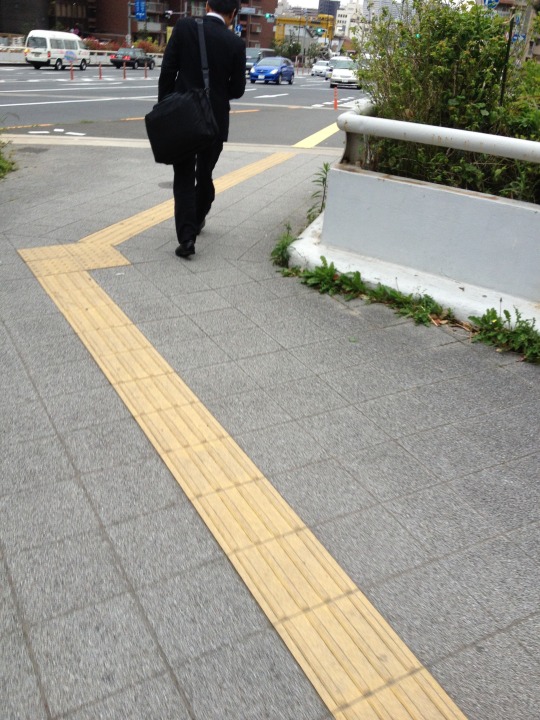


Not really a translation note, but “deer cola” felt especially funny in the context of all the horse medicine stuff.
I guess “[animal] [drink]” is a common branding device in-universe, given the crab beer Kobayashi’s always drinking.

Also not really a translation note, but the difference between how “hard” Kanna and Chloe are running to be at the same speed was a nice animation touch.

遊んだ遊んだ! asonda asonda!
One feature of the Japanese language is a very heavy use of repetition. This includes “reduplication,” a linguistic term for creating words by repeating a root (e.g. a “boo-boo” in English or the dara-dara example below in Japanese), but also just like… saying the same word multiple times, as Chloe does here.
Typically this is done for emphasis or to help increase clarity: if you’ve worked in a Japanese office, you’ve likely heard someone in a phone conversation say desu desu in response to someone asking for confirmation.
This acceptance of repetition sort of extends beyond the obvious uses like this as well: for example, personal pronouns are much less common; instead (if the subject isn’t dropped) you’ll often just use the person’s name again. You’ll notice similar trends with other types of words as well.
Not to mention the ubiquity of things like otsukare.
This often ends up being a challenge for translators, because reusing words in English (when it’s not for an obvious reason) tends to stick out rather unflatteringly, even if they aren’t that close together.
(Like when I overuse “hence” in these notes.)

This “Christ” in the Japanese was “ったく” (short for 全く mattaku, but just used as a semi-generic exclamation). I mostly bring this up because it’s a good example of a word that doesn’t work out of its cultural context; e.g. it wouldn’t make any sense for a fantasy character to say “Christ,” but since this is an American speaker it works just fine (and helps distinguish that fact, even).
I think I’ve mentioned this before, but English uses a lot of “explicit reference” words like this, that can break immersion if put in the mouths of characters who wouldn’t have exposure to said reference—which can be annoyingly limiting when trying to write dialogue sometimes.

As a bit of a culture shock for a lot of Americans I’ve met, most Japanese homes tend to have wall mounted air conditioning units, like this one, that are only for heating/cooling the one room they’re in. (Many also have a “Dry” setting that makes them act kind of like a dehumidifier as well.) It’s common to not have them in every room, like bedrooms, however.
This is in contrast to the central air conditioning system used by a majority of homes in the US (though type/use of AC in the US varies a lot by region; less common in the north for example)—and places like the UK where apparently residential AC units of any kind are quite rare.
You may have noticed that the doors between rooms always seem closed in Kobayashi’s apartment. That’s not just to make the backgrounds simpler, it’s also a good habit to keep if you’re going to be running the AC!


“Kobayashi, are you お休み today?”
“Yeah, お休み.”
お休み o-yasumi, is a noun form of the 休む yasumu, to rest. The word has a variety of applications, as we see here. A day off work/school, i.e. a rest day? お休み. Want to say “good night” to someone before bed? Also お休み.
In this case, it’s not even necessarily clear it’s being said as a pun; as mentioned earlier, repetition is a common feature of the language, so despite the yawn there wouldn’t really be any reason for Kanna to think Kobayashi was about to go to nap or anything.

“Laze about” here is だらだら dara-dara, another phenomime (擬態語 gitaigo in Japanese)—one of those words that mimics the “sound” of an idea/concept/state, which don’t actually make a sound per se.
These phrases aren’t necessarily childish or anything (overuse of them can be, but you can find them even in news articles and political speeches for example). They are, however, used frequently by children, and by adults talking to children, as they’re very “easy” words: they’re expressive, they capture useful daily-life concepts, and they usually roll off the tongue. You’ll notice, for example, that Kanna uses them a lot.
Kanna has a very interesting way of talking actually, which I’ll touch on a bit more later.

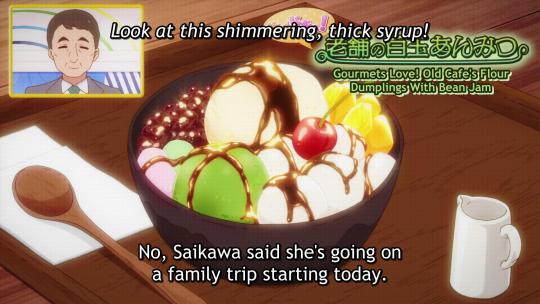
Kobayashi’s “bean jam” here is あんみつ anmitsu, a traditional Japanese dessert (technically a spinoff of mitsumame). It typically is a mix of red beans (and/or red peas), agar (an algae-based gelatin equivalent), some fruit, some variety of rice flour product (shiratama in this case, similar to mochi), and a syrup (often black sugar based).
You can find it year-round, but it has a strong summer association and is even used as a summer season word. (It’s typically chilled and you can often get it with ice cream as an ingredient.)
It’s also sometimes paired with a green-tea flavored something as well (e.g. ice cream, agar, or syrup). The trinity of green tea, red beans (aka azuki), and shiratama makes what I like to think of as the “Japanese S’mores Flavor (for Adults)”. No I will not elaborate on this.
I will though point out the shaved ice flavor Kobayashi ordered later in the episode:
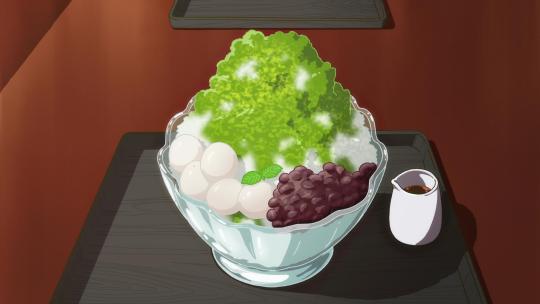

え?今スイカ様子あった?
A word of note here for language learners is 様子 yousu, which has a lot of definitions, but in cases like this where it’s attached to a noun or phrase means roughly “the appearance of __” or “an indication of ___” etc. In actual use, it typically means something that makes you think of whatever ___ is—or the lack of something that would make you think ___.
For example here, it’s like “Watermelon? Where’d that come from?” (since the TV was talking about a different dessert-y food entirely).
Or an unrelated example: “I think that guy is hiding something” → “Really? I haven’t seen any yousu of that.” In other words, it can be a lot like “sign,” as in “I’ve seen no sign of ___.”

These color-bordered envelopes (originally colored based on the flag of the country of origin) used to be the standard for air mail, domestic or international, though they haven’t been required for several decades.
That said, they’re still popular for that “ooh, international mail!” feel (at least in Japan) and you can buy them at most places that sell stuff like envelopes. As here, they’re often used in media to immediately convey that a letter came from outside Japan.
Kanna (and Kobayashi) says エアメール, lit. “air mail” in English, which is used colloquially for international mail specifically, rather than “mail sent by plane.”
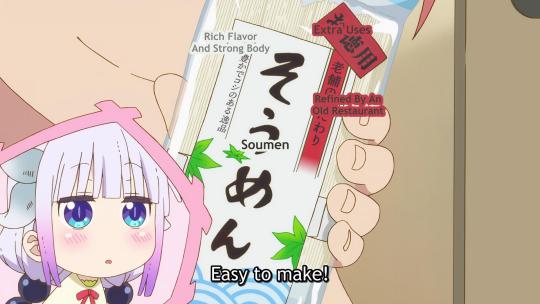
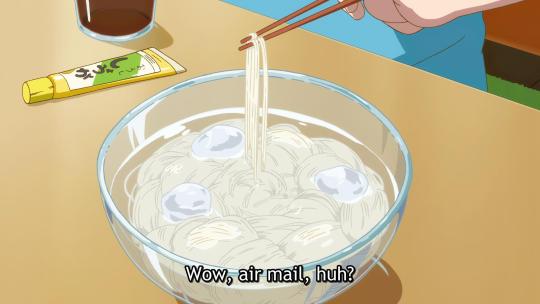
They’re having what’s called 冷やしそうめん hiyashi soumen, chilled/cold soumen for lunch here. (Soumen being a thin wheat noodle; udon but thinner.) As Kanna says, it’s very easy to make!
Basically you just boil it, wash it in cold water, add ice, get some sort of sauce to dip it in, and you’re done! It’s a popular quick meal in summer, and much easier than the more involved nagashi soumen setups you may have seen elsewhere, where they slide the noodles down a chute for you to try to grab and eat. (It’s basically the same meal aside from that though.)
(You can of course add more to it, but as we see here, you don’t really have to.)

The type of tea here, for the curious, is 麦茶 mugicha, barley tea. Mugi is the general name for cereals/grains including wheat (komugi), barley (oomugi), rye (kuromugi or rye mugi), and oats (enbaku or oat mugi). It’s incredibly common in Japan (and much of East Asia), where it's the household summer drink.
It has no caffeine like many other teas, and has a bunch of various nutritional benefits, so it’s considered a good way to stay hydrated as you’re sweating buckets in the muggy Japanese summer weather.


帽子した? boushi shita? した! shita!
I thought this was a cute way of phrasing this question/answer, and a good example of the “parent and their young child” way these two talk.
The suru (past tense shita) verb used here is the ultimate in “generic verb,” and it basically doesn’t get any simpler grammar-wise to phrase something as “noun+suru” like Kobayashi does here (even the particles are dropped).
Kanna, for her part, doesn’t respond with a “yes” or etc, but instead just repeats back the verb itself in confirmation.


Just to note another one of those words like dara-dara: bura-bura, used for things like wandering around, doing something (or nothing) casually/aimlessly, or (with one bura) for something dangling/swinging in a more literal sense, like a spider, slack yo-yo, or wind chime.
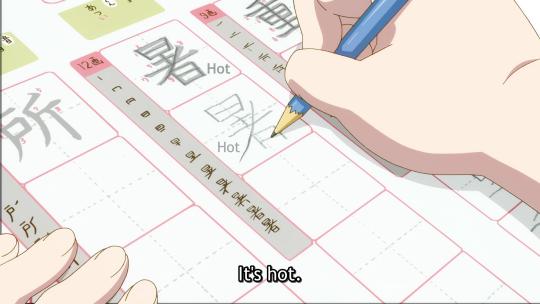
These booklets are a common homework assignment for practicing kanji; you can see along the left side there it shows the stroke order, with the first block giving an example to trace over & showing where to start each stroke.
Each character is made up of radicals (e.g. “hot” above: 日 and 耂), which each have a standard way to write them. There’s 214 such radicals (though many are pretty niche; only about ~50 of them are needed to make most characters), and once you get a hang of them it makes learning new characters much easier (not too different from learning word spellings in English imo).
Kanna is repeating out loud the reading for the “hot” character as she writes it.


In addition to the above workbooks (which usually involve both kanji and math problems at Kanna’s grade), elementary school summer homework in Japan typically involves doing an illustrated diary (not a daily one necessarily) and some sort of research project about a subject of your choice. (Think kind of like a small science fair project).
The “research” project part is pretty expansive, and you can typically even do something more arts & craftsy for it.
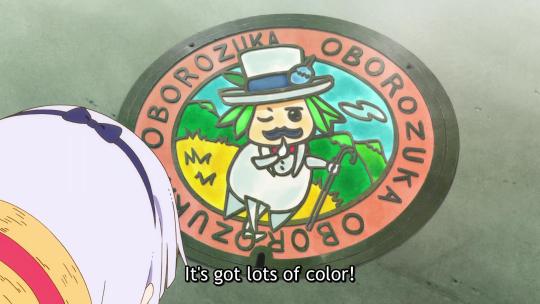
Manhole covers in a lot of Japanese municipalities feature art representative of the area. For example, the city of Chofu, where the author of GeGeGe no Kitaro lived most of his life, has several with art of that series.
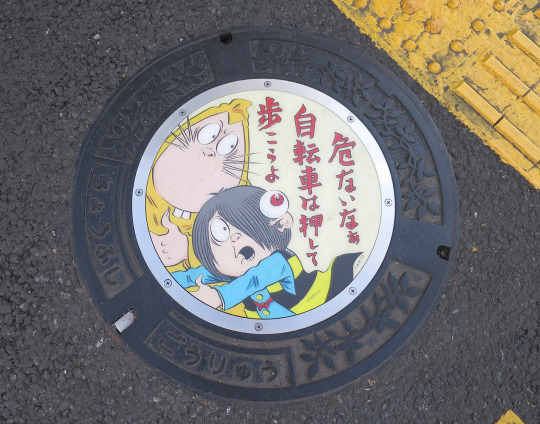
(Photo from https://www.gotokyo.org/jp/spot/1734/index.html)
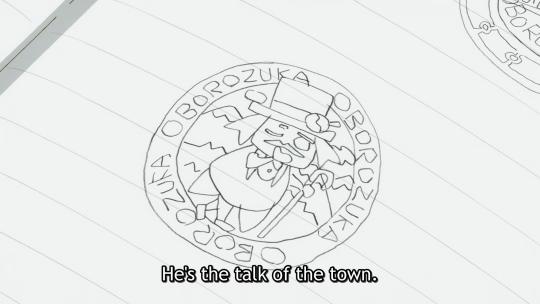
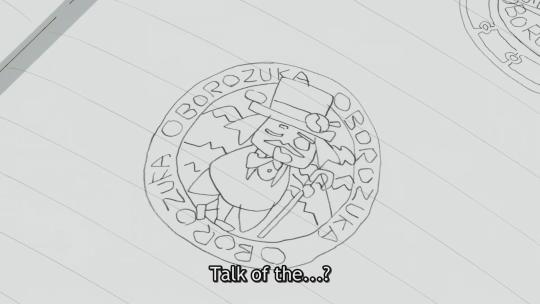
I mentioned earlier that Kanna has an interesting way of speaking. Probably a better way to put it is that she has a pretty convincingly childish way of speaking (despite the monotone). That is, she uses simple grammar and “easy” words most of the time, but then throws out random big words and fancy idioms from time to time that make you go “...where did you learn that?”
In this case, the phrase she uses is 巷で人気 chimata de ninki. Chimata originally means like a fork (in the road), and since those are often places with lots of people passing through, it expanded to mean “the undefined place where people talk about ~stuff~.” So it’s used for “many people are saying~” or “word on the street is~” types of situations (or “talk of the town,” as here).
It’s kind of an “adult” word though; for example the character for it isn’t included in the jouyou kanji (the 2000+ that are taught in elementary through high school). Hence Kobayashi’s reaction here.

The word she uses for “protected” here is 死�� shishu. The word is the combination of the characters for “death” and “protect,” ~meaning to protect something even at risk to one’s life (to the death, as it were).
It's a word that you learn in third grade in the Japanese education system—the same grade Kanna is in!


Both of these types of signs are common sights in residential areas like this: depending on where you live, it can feel like there’s always some sort of construction project going on, and Japan’s many family/individually-owned businesses like this tend to be closed on various extra days during the summer (and certain other times) to allow for time off.
In this case, them being closed August 12th~16th implies they’re taking off for Obon (and probably leaving town to visit family).
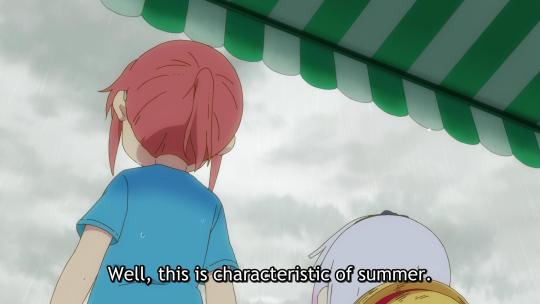
The word Kobayashi uses here is 風物詩 fuubutsu-shi. Fuubutsu refers to something that makes up part of the “scenery” of a place or season, in a pretty broad sense. This shi typically means “poem.”
So fuubutsu-shi is originally a type of poem celebrating a season or a scene of natural beauty, that sort of thing. From that, it’s also now (more popularly) used to describe things that are representative of a season; the kind of stuff you say “it’s not winter until…” about, or “you know it’s summer when…” (It can also be used for places + seasons, like the ice sculptures of Hokkaido winters, or even summer Comiket in Tokyo.)
They’re very similar to the season words I’ve mentioned previously, though they’re far less strict about what counts as one. Here, Kobayashi’s could be referring to the whole package experience of “having to take cover and wait out a sudden heavy rain, despite it being mostly clear skies a few minutes ago,” which you could call fuubutsu-shi (summed up probably as like 夏の雨宿り etc.)
In contrast the relevant season word here would probably be yuudachi (or niwaka-ame), a word referring to the short, sudden bouts of rain that tend to fall (from cumulonimbus clouds, the makings of which are noticeable in the backgrounds before this) on summer evenings.

Feels like in season one she woulda eaten it. Three cheers for character growth!
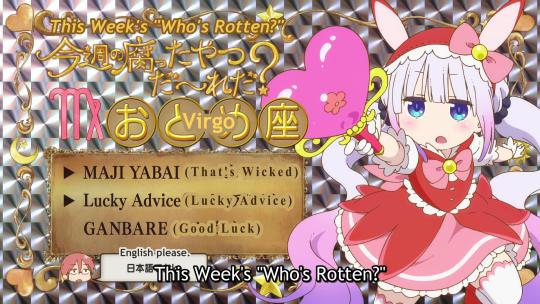

The parentheticals there are just the “English” in hiragana/katakana.
Kobayashi’s comment (nihongo de ok, roughly “you can just use Japanese”) is an internet-born term people originally would use to reply to someone who said something that didn’t make any sense, had terrible grammar, or was so full of katakana loanwords it was hard to read etc.

Kanna says this line in English, and while I have no proof at all, my guess is that the specific choice of “wicked” was taken from the translation of “maji yabakune?” used in season one.
13 notes
·
View notes
Text
Saturday 16 May 1840
[up at] 3 35/”
[to bed at] 12 10/”
Reaumur 14 1/2º at 4 a.m. in our room and Fahrenheit 65.º (both marked on same little Bate London thermometer) breakfast – rice and tea – washing up, and not off till 5 10/” – at 1st station at 6 8/” i.e. 15 versts in 58 minutes! beautiful morning – sun hot now at 6 1/4 – fine rich pasture valley, grass and herbage, thistles, etc. all along – much cattle – station house just like that last night of Karamarianskoi – the 2 first of this kind
5 10/” to 6 8/” Karamarianskoi to Kululinskoi 15
6 35/” to 8 35/” Karamarianskoi to Novoshemacha 18 1/2
33 1/2
low, one story building – 2 wings and a front something of this sort

one door in each wing and a room, and 2 doors in the front and a room on each side of each of these 2 doors – very fairly off last night – better than in our Caravanserai at Elizabethpol – en route again at 6 35/” – at 7 1/4 at river – and river at 8 20/” and at 8 25/” village and station house of Novo Shemacha (new Shemacha) – a general just gone, has taken 16 pair of oxen to get him up the mountain – no horses, nobody allowed to have horses but the post – no oxen – alight for the day – Ann and I went out immediately and sauntered about till 10 1/2 – a little Gastinoi Dvor bazaar, at a little distance in front of the village well supplied with the usual commodities hereabouts – Dried fruits and nuts (walnuts and filberts almonds) and dates and jujubes, and rock salt, and garance (madder) the root called . . . . . but the root ground to a fine powder is the henna with which they stain dye their nails a red orange colour – there was also abundance of the yellow green powder with which they dye their beards black – there were several sorts of cake (apparently of wheat flour) and split peas and beans and lentils, and a largeish roundish 1/4 inch or less thick queer dark looking cake which they let us taste, a veritable plum cake i.e. of plums dried and pressed into this shape – there was a butcher’s shop, and the man killed a sheep (fat-tailed) before our eyes – cut its throat and let it bleed to death – several little saussage /sic/ shops – the sausages in all stages of preparation, and also ready cooked to eat – there was also a plat of eggs poached in oil and eaten with cake, 1/2 dozen men at one dish – dipped in the cake, and took out the egg with their fingers, and one of the men held out a bit for me to taste – I ate it off the man’s fingers and found it very eatable – sauntered down ino a nice garden – 3 or 4 houses (low mud-covered places as usual) but carpeted and neat within – the women flocked round us ditto their husbands (or 1 or 2 men) – they had largeish, oblong shallow cartons in their rooms under the stone bench full of silk worm eggs placed on mulberry leaf buds – a youth offered us green plums (magnum bonum just well set) to eat carefully taking out the little kernel which they made us understand was unwholesome – they took us to another cottage where the husband was weaving a Tchadra veil of the women of the country – shewed us one – price 3 monāt i.e. 3/. Silver rubles – sat down to my accounts at 11 – dozed over them – lay down – slept till 3 – then till now 5 1/2 finished my accounts – then at Journal and map till dinner at 7 1/4 to 8 20/” – then preparing bed etc. etc. till now 9 1/2 – then at Journal again till now 11 p.m. beautiful night – Reaumur 14 3/4º and Fahrenheit now 11 25/” p.m.
Anne’s marginal notes:
general Fezey commandant at Kuba – who we met at Madame Latchinoff’s, and found at Baku.
Henna.
NB: All unannotated (no links, explanations, illustrations etc.) entries will be annotated in the future and reposted.
WYAS page: SH:7/ML/E/24/0106
#anne lister#ann walker#anne lister code breaker#gentleman jack#russianempire1840#azerbaijan1840#diary1840unannotated
3 notes
·
View notes
Text
Timestamp #226: Let's Kill Hitler
New Post has been published on https://esonetwork.com/timestamp-226-lets-kill-hitler/
Timestamp #226: Let's Kill Hitler
Doctor Who: Let’s Kill Hitler (1 episode, s06e08, 2011)
Hello, sweetie.
Prequel
A phone rings as the TARDIS is in flight. The answering machine picks up and Amy leaves a message.
As the camera pans across the console and the dark control room, Amy asks if the Doctor will fulfill his promise to find Melody Pond. Even though she knows that everything turns out okay, she doesn’t want to miss Melody’s childhood.
The Doctor listens intently, but doesn’t pick up the phone. He’s clearly wracked with regret and sadness.
Let’s Kill Hitler
It was once a nice wheat field. Then the Ponds plowed through it, scrawling the word “Doctor” into the crop. They stop in the middle of the O – a giant crop circle – to find the TARDIS and the Doctor in his new pea green double-breasted coat. The Doctor shows them a newspaper article chronicling the event.
It turns out that this was the only way Amy and Rory could figure out to get the Doctor’s attention. He consoles Amy: He will find Melody because River lives. The moment is shattered by police sirens, a speeding red car, and a woman named Mels. The new arrival holds the Doctor at gunpoint and demands to be taken in the TARDIS. It seems that she wants to kill Adolf Hitler.
Flash back to a long time ago in Leadworth as young Amelia, your Rory, and young heretofore-unknown Mels grow up together. Apparently, Mels knows all about Amelia’s “imaginary” friend, the Doctor, and that knowledge gets her in trouble. A lot. Including stealing a bus. She’s also present when Amy finally figures out that Rory loves her.
In the present, Mels, Amy, and Rory take a trip in the TARDIS. Mels actually shoots the TARDIS console while in transit to Nazi Germany. In Berlin, 1938, those same Nazis are being observed by a team with future technology as a machine (posing as a custodian) shapeshifts into a Nazi officer. That team is inside the machine, a highly advanced ship called the Teselecta, which shrinks the Nazi officer and draws him inside. Since the officer is responsible for a series of hate crimes – after all, what Nazi wasn’t? – he is disposed of by a series of “antibodies”.
The Teselecta then goes to Adolf Hitler’s office and activates Justice Mode, but two things interfere in the plan. First, they are too early in Hitler’s time stream. Second, the TARDIS crashes through the wall into the office.
The Doctor evacuates everyone from the TARDIS as it smokes away, then stashes Mels’s handgun in a bowl of fruit. The travelers are beside themselves for actually saving Hitler. The Teselecta tries to attack Hitler again, but he shoots the ship before being stashed in a nearby cupboard by the Doctor and Rory. The Teselecta feigns a fainting spell while the crew analyzes the TARDIS and determines that the most wanted war criminal in history has arrived.
Also, Mels has been shot by Hitler.
Mels, short for Melody, regenerates into a very familiar form. Mission complete. Well… sort of. This new woman has no idea who any of her traveling companions are, she is incredibly self-centered, and has maintained her programming that demands murdering the Doctor. She tries multiple times with every weapon in the room, but the Doctor is several steps ahead of her, but he misses the poison lipstick.
Melody jumps out of window and takes on a squad of Nazis. The soldiers try to shoot her, but she survives due to her regenerative state and uses the discharged energy as a weapon. She picks up their guns and drives away on a motorcycle. Rory and Amy give chase with the sonic screwdriver, followed by the Teselecta disguised as a Nazi soldier.
The Doctor enters the TARDIS and extracts the smoke. He consults with the TARDIS voice interface – the sequence of trying to find a face that doesn’t remind him of his failures is hilarious – and determines that regeneration is impossible due to the poison extracted from the Judas tree. The interface mentions “fish fingers and custard,” inspiring the Doctor to set a course in the TARDIS.
Melody storms a restaurant and demands that the patrons give her their clothes. Outside, the Teselecta takes Amy’s form and miniaturizes Amy and Rory. Just before being killed by the antibodies, the Ponds are given clearance privileges and taken to the control room.
The Teselecta nearly passes judgment on Melody for killing the Doctor, but the Doctor arrives in a tuxedo and top hat. He uses a sonic cane to scan the ship. He also verifies that the Ponds are okay. The Teselecta places Melody in stasis before the crew explains that the mete out justice to war criminals at the ends of their respective timelines. Amy convinces the crew to offer any help they can to the Doctor.
The Silence, a religious cult who believe “silence will fall” when the oldest question in the universe is asked, are behind the plot to kill the Doctor. When the Teselecta crew reveals that they don’t know what the question is, the crew resumes their torture of Melody.
The Doctor asks Amy to save her daughter, so Amy disables the crew’s privileges so that they will all be attacked by the antibodies. The Teselecta releases Melody and the crew is teleported away to a mother ship. As the antibodies descend on Amy and Rory, the Doctor tells Melody to save her parents.
As the Doctor faces his imminent demise, he begs Melody to help him. She talks to the TARDIS and learns to fly the ship, rescuing Amy and Rory before returning everyone to the Doctor’s side. Melody Pond, a child of the TARDIS, wonders who she is. The Doctor asks her to find River Song and pass on a message.
As the Doctor falls unconscious, Melody asks who River Song is. Amy uses the Teselecta to show Melody her own face. Melody decides to pass on her regeneration energy – all her remaining lives – to the Doctor with a kiss, thus becoming River Song.
River wakes up in a hospital with the travelers looking on. The Doctor’s message was that no one could save him, which made her think that she could. This is how she learns Rule #1: The Doctor lies. The travelers leave her with the Sisters of the Infinite Schism to recover, complete with an empty TARDIS-shaped diary. She’ll find her way back to them in time.
As the Doctor ponders the data he downloaded from the Teselecta, River Song enrolls at the Luna University in 5123. Her motivations are simple: She’s looking for a good man.
There are a couple of items working against this fun ride: First, the introduction of the previously unknown Mels. Second, the crux of the assassination of the Doctor relies on him being the smartest man in the room again.
The first can be explained if we’re looking at the events of this season through Amy and Rory’s perspective, therefore seeing a low-impact change in the timeline after Melody’s birth and abduction. The second, while an annoying feature of the Steven Moffat era of Doctor Who, adds a lot of humor and hangs a lampshade on the Doctor’s blind spot for River Song. Especially considering the fact that she is the person who kills the Doctor, an act for which she is imprisoned and is now revealed to be a fixed point. The second also hearkens back to the Ninth Doctor in Boom Town, but it worked there because it wasn’t as much of a storytelling crutch for Russell T. Davies.
That humor, coupled with the character development for River and the Doctor, really makes this story work. The origin story for River Song helps tie off her story and could have provided a convenient story terminus if not for the character’s immense popularity.
The humor also worked because it was self-deprecating. The scene with the TARDIS voice interface poked at the ongoing theme with companion departures and shame, invoking Rose, Martha, and Donna in the process. The scene also point us back to a moment of combined shame and innocence by invoking Amelia Pond, whom the Doctor had not yet screwed up but did leave hanging for her childhood years.
Going back to Rule #1, we find out in this story that temporal grace – the state in which the TARDIS interior exists – houses a “clever lie”. The Fourth Doctor claimed that weapons could not be used inside the TARDIS in order to stop Eldrad in The Hand of Fear. Of course, we already knew that it wasn’t absolute from Arc of Infinity – “Nobody’s perfect,” claimed the Fifth Doctor when challenged by Nyssa about a Cyberman shooting in the console room – as well as The Invasion of Time, Earthshock, Attack of the Cybermen, The Visitation, and The Parting of the Ways.
With all of the discussions about Doctor Who canon/continuity in fandom, it’s a good reminder that Doctor Who canon/continuity has never been consistent.
This story also presents a fascinating parallel to The Caves of Androzani, during which the Doctor was poisoned by could survive by regenerating. The Doctor had several lives to spare at that point, but this encounter comes at the supposed end of the Doctor’s regeneration cycle due to the events of Journey’s End and The Night of the Doctor.
There are also several other franchise callbacks: We’ve seen “justice machines” in the past, though they were in the form of the Megara; We’ve previously seen the TARDIS materialize in a micro environment, courtesy of Carnival of Monsters, and materialize in a micro state, courtesy of Planet of Giants; We’ve seen the TARDIS materialize around people and objects before in Logopolis, Time-Flight, The Parting of the Ways, and The Waters of Mars; We’ve also heard about transferring regeneration energy in previous adventures like Mawdryn Undead, the TV movie, and The Ultimate Foe.
I’m also a sucker for the “Doctor who?” title drop gag, which has been around since the beginning. It makes me snicker every time.
All told, I really enjoy the action, the spirit, and the heart of this story. It takes a tired time-travel trope (“Let’s kill Hitler!”) and turns it on its ear to both develop characters and move a story along. Well done.
Rating: 5/5 – “Fantastic!”
UP NEXT – Torchwood: The Gathering
The Timestamps Project is an adventure through the televised universe of Doctor Who, story by story, from the beginning of the franchise. For more reviews like this one, please visit the project’s page at Creative Criticality.
1 note
·
View note
Note
dad!h being the worst healthnut when it comes to his lil baby because nothing seems good enough; reads every study about organic food and makes everything himself; only buys the best clothes made out of organic cotton; the lotion needs to be tested on his skin for a week first before being used on the baby
This is honestly so canon for dad!Harry. You’re spot on!
Harry comes off as a well-rounded health nut himself, so you know for a fact that would translate over to how he tends to his child. He’d be determined very early on before the baby was even born to only let them come in contact with the best quality baby items! Right on the head about the organic cotton onsies, he’d be too worried the synthetic kind would irritate their sensitive skin and fear that regular baby lotion would break them out or not hydrate their frail body well enough. I also see them wearing one of those little amber teething necklaces from the time they were practically newborns up until they’re well into their toddler phase.
As far as food goes, 100% that Harry would try to make his own baby food. Canned baby food has too many preservatives and there’s no way Harry would eat the murky gunk that’s apparently mashed peas and carrots, so why would he feed it to his baby? He’d set aside time each week, trying new mixes as he adjusts to what he finds out his bub does and doesn’t like (you know any child of Harry’s would love bananas, so Harry would be buying them in bulk after having a baby). Picture Harry letting them eat some of his morning smoothie that’s packed full of shit like kale and ginger and them just absolutely loving it because that’s what they’ve grown to enjoy and they don’t know any different. I’m not sure if this is weird or not, but that is absolutely adorable to me! Just thinking about how Harry would look at the kitchen table answering emails with the baby bouncing on his lap, sucking on their sippy cup that’s full of the same liquid Harry has in his 🥺
I also see him trying to keep his bub from having too much artificial sugar. He’d tell them as they’re sat in their high chair that sugary cereals like Cheerios rot your brain before he presented them with some overpriced, organic wheat puffs or something of the sort. They’d have absolutely no idea what Harry is saying to them because they’re merely 6 months old, but they’d still flail their arms around the high chair and coo at the bland little snack Harry had given them.
He’d go absolutely mad trying to keep Gemma and Anne from stuffing them full of garbage, and he’d eventually find out they only did it to rile Harry up. When he picks bub up after a play date with Auntie Gem and sees their lips coated in a red, sticky mess, he’d be visibly twitching and give Gemma a proper cursing out. But all jokes aside, he does give them a little something special on birthdays or whenever everyone else is having some and the baby gets antsy from not being able to indulge with them. He doesn’t want to rob his child of any fun, but he also just wants what’s best for them.
With all this being said, I feel like this reigns mostly true for Harry’s first baby. He’d definitely end up with a clan of curly headed bubbies causing a storm in his house, so I think he’d end up giving up after the second or third baby. He’d try all he could to get them to snack on avocado slices or peaches, but sometimes if all a screaming, teething baby needs is a damned Cheeto puff, perhaps Harry can learn to let it slide.
#harry styles fanfiction#harry styles x reader#dad!harry x reader#harry styles imagine#harry styles blurb#harry styles one shot#dad!harry#asks
130 notes
·
View notes
Note
actually; barley, fonio, maize, millet, oat, rice, rye, sorghum, teff, triticale, spelt, wheat, amaranth, buckwheat, quinoa, lupin, pea, peanut, soy, almond, brazil, cashew, hazelnut, macadamia, pecan, pistachio, walnut, chia seed, flax seed, hemp seed, pumpkin seed, sesame seed, sunflower seed, coconut, potato, and tiger nut are all apparently sources of plant based milk!
okay that would actually make a lot of sense since cephalings seem to love plant-based food
2 notes
·
View notes
Text
As promised my gyoza recipe (for people who hate cabbage)
Alright, buckle up :
Dough (a basic 2:1 flour : water ratio works if you want to make more/less)
300g white wheat flour
150 ml water
pinch of salt
Some people swear by scorching hot water but I just used as hot as my sink went. The most important part is: kneading! Knead the dough at least 5-8 minutes. Really work it! Then I left it to rest for a couple of hours, but I'd say 30min is fine.
Filling (which I didn't cook or fried)
1 block smoked tofu
1/2-1 cup peas (probably less. I don't write down my recipes)
1 medium sized carrot peeled and shredded
4-5 chopped mushrooms of your choice
1 stalk spring onions chopped
1-2 Tbs sesame seeds
1 clove of garlic chopped
2-3 generous cm ginger grated
1/2 chili
Juice from 1 orange (you can also add some cest)
1 tsp sweetener of your choice (honestly I am addicted to golden syrup but that 's for another story)
2 Tbs soy sauce
1 Tbs (rice) vinegar
1-2 dashes of Sriracha or Sweet Chili sauce
Some pepper
Some ground up cumin to taste
As said I didn't cook my filling, I basically just chopped everything and added dressing.
Assembly
Roll our your dough as thin as it goes (or to step 5 of your pasta maker) and cut round pieces with the rim of a wide mug or a small bowl. Now for folding it's key to have really DRY hands. Some sources said you had to seal the dough off with water but I forgot most of the time and it was fine. Place the round dough in the palm of your hand, add some filling... About generous table spoon was fine for me, then fold the dough in half. Start sealing off by folding from the very middle top outwards, one side then the other. Place with generous distance to one another in a steaming basket lined with parchment paper. (apparently dumplings have to distance too, otherwise they stick to everything) Steam for about 15-20 minutes.
Remove, then fry up in a hot pan until the bottoms are crisp.
Enjoy! (I am a heathen, you can make fancy sauces, but I recommend Sriracha mayo and satésauce) If you have filling left it's great with pasta as a stir fry.
You can make makeshift steaming baskets, look it up on YouTube! Otherwise I think a rice steamer is super affordable.
#Aardventures#Aard answers#My pictures were super unaesthetic soooo#I want to spare you brown on brown lol#I mainly eat stones grass and the occasional soup#Vegan#Plant based#Gyoza#Cooking
37 notes
·
View notes
Text
Rat Mix!

Here is the food I have for my rats! Their daily feed will be the Oxbow Adult Rat food in the back there. The rest of it I’m gonna mix together and give it occasionally alongside the rat food just for some variety. Pics and Prices and Proportions under the cut:

Oxbow adult rat food from Chewy 40-lb bag: $40 Dog food Beyond brand, super food blend: $10.49

Oats & O’s multigrain Giant brand cereal: $2.69 Old Fashioned Oats: $2.49 (Might switch out the Old Fashioned for Steal Cut for a less processed grain)

Whole Roasted Barley: $2.49 each

Flax Seed: $2.29 Split Peas: $1.29 Long Grain Brown Rice: $2.29

Goya Shell Pasta: $.59 each

Whole Pumpkin Seeds from Amazon: $9 Mother Earth Products Dried Carrots from Amazon: $10.49 Organic Coconut Chips: $4.49 Parsley Flakes: $2.59
All together around $50 for everything besides the two pet foods. I did go back and buy some more barley, some soft wheat kernels, and some more pasta, and a box of Life multigrain cereal to round out the nutrition, all of which added up to about $10. For proportions, I’m cutting the Flaxseed, Split Peas, and Carrot in half, and will only use one third of the Pumpkin seed. I am gonna use 4-1/3 cup of the dog food, it’s about 485g according to the feeding instructions. I decided not to cut down on the coconut cuz i hear its good for them? The ratios somewhat follow the Isamu Rat Diet guidlines: 46% Straight Grains (minimally processed, like the rice, barley, and wheat) 32% Processed Grain (these have vitamins and minerals added typically, like the oats, cereal, and pasta) 7% Protein (basically meat, and since the dog food is fish based it should have some omega fats in it too) 10% Herb and Veg (Carrots, split peas, and parsley flakes, tho I’m also including the coconut flakes in this) 5% Seeds (I was gonna use much more of the flax and pumpkin seed, but apparently should be very very little)
And of course the Oxbow will be given 50/50 whenever i give them the mix.
This mix has a lot of potassium, but it also has plenty of iron and calcium. I think it has enough copper too, tho I’m not sure about the amount. I’ve also noticed Vitamin A, B, C, D, and E in these ingredients. Vitamin D is the only thing I think is really lacking, but I will try to supplement D, copper, and calcium from fresh foods every week. I hear eggs, mushrooms, fish, and tofu are good sources for these.
Anyway, I hope this was at all helpful. It’s not a perfect mix, and it’s not their main diet, it’s just something I wanted to do for fun. I hope it helped you come up with your own ideas on what to feed your ratties!
25 notes
·
View notes
Text

* LOCATION SERIES: THOR’S RESIDENCES.
as the god of clouds, thor is scarcely at home and instead, he's always out and about either seeking adventure or on call for his skillset by gods and worshippers alike. this being said, he has a number of established homes both in asgard and in midgard that he frequents and could be found at whenever necessary.
ASGARD.
in the lore, thor is ascribed three dwellings -- þrúðheimr / thrudheim, or the world of might and strength, which is mentioned as his realm or kingdom (grímnismál, 4), bilskirnir, or lightning-crack, which is specified to be the name of his hall or mansion (also mentioned in grímnismál), and Þrúðvangr / thrudvang, or power-field, which could be interpreted as a different name for thrudheim, yet i chose to view as just a different location within the realm (pictured above).
as always with norse myth, not much is mentioned about any of these places. thus i choose to take some creative freedoms with their descriptions and specifications. however, according to the norse myths by heilan yvette grimes, thor was born actually in midgard/verland (the land of men) with his mother jord (noteworthy for being the personification of the earth, and a jotunn). he was quick to grow and soon jord realized she could not manage him. at just a few months old he was able to lift and kick off the ten loads of bearskin piled on his cradle to keep him warm, a worthy feat for a grown man and inimaginable for an infant. all around, he apparently got on her nerves a lot (according to etter robert james, he was all around a handful, throwing massive and destructive fits, pulling at his parents hair and ears and being a little shit all the time, basically), so she sent him to the giants vingnir and hlora to be raised as their foster son in jotunheim, the reason why sometimes thor is referred to as vingthor and hlorridi.
one small detour: in the endnotes to his translation of the völsungasaga, jesse l. byock explains: “fosterage was a norse custom of having a child raised in another household in order to extend kinship bonds or to form political alliances”. since we have to assume that the giant-asgardian conflict was still alive and well while thor was growing up, it's good to keep this in mind for later reference -- maybe not for this post, but in general.

thrudheim.
upon his return to asgard, and after killing a rock giant that threatened the aesir, thor was rewarded with some lands upon which he built a estate, and that estate was called thrudheim. in stanza 4 of grímnismál it is described as "a land [that] is holy, which i see situated near the aesir and elves". not much else is stated about the kingdom. some believe that in the afterlife worshippers of thor may end up in it, but unlike what you may think, not many of these worshippers are warriors. those tend to go to valhalla (the hall of odin) or folkvang (the hall of freya). instead, thor's hall tends to receive the common folk, peasants, farmers and workers of the land, and only a certain type of those who die in battle (primarily the "thralls", as in the servants and slaves, as opposed to the noble warriors, who will go to odin's hall). this much is mentioned in hárbarðsljóð, where odin (disguised as a ferryman) openly mocks thor with this fact during a verbal spat.
so, knowing the population it will have, we can guess that the kingdom counts with many of the amenities of a large, tightly packed farming city. i'd also envision it surrounded by farms and crop fields, specially wheat fields considering that sif, thor's wife and an earth goddess, would be living with him. it's these fields what i would call thrudvang and what would give thrudheim the appearance of being washed in gold -- on top of, of course, the gleaming strikes of lightning that would be frequently seen in the cloudy skies. it's likely the kingdom plays a big role in asgard as a hub for agriculture and livestock farming -- i.e much of the food (and some of the mead) the gods eat and drink comes from thrudheim. the harvests would be always bountiful and perfect, thanks to the kind weather and generous soil endowed to the realm by thor and sif respectively. there would be crops and flora of all kinds, as it's a very lush place, but it must be mentioned particularly the presence of oak forests due to their significance in thor's worship, as well as other plants and produce: the ash, the hazel, the birch, the rowan (also due to sif), the thistle, garlic, onion, houseleek, leek, vervain, burdock, hawthorn, the blackthorn, bramble, holly, nettle, and the rose, all of which have special properties and meaning in the cult of thor. (may be topic for a different post)

bilskirnir.
the massive hall was built for thor also around the same time as thrudheim was established as his estate. grimnismál, stanza 24, has odin reveal the following vision as he catalogs the dwellings of the gods: "five hundred rooms and forty / there are, i think, under the arches of bilskírnir / of those halls which i know to be roofed / my son's is the biggest." in gylfaginning, when he introduces thor, snorri has hár say that thor has a kingdom and a hall called bilskírnir with 540 rooms, which is the greatest of buildings, equal only to the one in valhalla. in skáldskaparmál snorri says that "owner of Bilskírnir" is a valid thor kenning, and in fact "prince of bilskirnir" is attested in the skaldic corpus. the meaning of the name is unclear, but it seems to be either "suddenly illuminated (by lightning)" or "everlasting." according to heilan yvette grimes, in bilskirnir, thor's fallen worshippers "guaffed mead and banqueted on enormous meals, and practiced their warrior skills in preparation for the last fateful battle." in regards to appearance grimes also noted that the outside of bilskirnir was studded with shields and glowed red in contrast with the inside which was a gleaming purple.
it's a gigantic "mansion", but more than that, it's tall enough to reach the skies, as apparently thor frequently shoots lightnings from the top floor. it's also here specifically where he's said to live with his wife and children.
MIDGARD.

palafito in ologá, venezuela.
ologá, in contrast to the realm of thrudheim, is a tiny settlement where less than 50 families reside in stilt houses, or palafitos, which are houses raised on piles over the surface of the soil or bodies of water. it's located south of maracaibo, 1m over the water level, and it's a community of fishermen. it's sustained mainly by said fishing but also by tourism, as it's from its palafitos that the world-famous catatumbo lightning can be comfortably seen and photographed. (you can click in their names for some nice galleries featuring catatumbo and ologá)
thor feels a natural connection to the place, given its peculiar atmospheric conditions which make it so predisposed to thunderstorm activity and lightning (which occurs during 140 to 160 nights a year, 10 hours per day and up to 280 times per hour). he has a natural pull to it, drawing special strength from the perpetual storm, which sent him to the small town sometime around the mid 50s and made him build his own stilt house there, keeping in mind his size and height, something that quickly made him the object of curiosity from the locals. he made his most used human persona, dario belmonte, be born here, and he became a very active figure in the town as a fisherman, builder, and healer and all around friend to everybody. it got to the point that eventually he pretty much confessed (more or less) his status as a god to the entire town, as there was no other way to explain his lack of aging and magical abilities. to this day, they continue to keep his secret, and he visits them sporadically every few years to make sure they're doing well.
his palafito is not more lavish than any of the other houses in the settlement and it's made from the same materials. it's a two room house and anyone else is free to use it whenever he isn't here -- he usually leaves it to his neighbors so they can rent it to tourists.
in his post-ragnarok verse thor, who was meant to die after his battle with the midgard serpent, ends up coming back to "life" in the depths of the maracaibo lake during one of the loudest thunderstorms the townsfolk had ever witnessed. he's found floating unconscious by a couple fishermen in the morning and taken to the house of one of the older citizens, who recognizes him. he's nursed back to health and it's from this point onwards that thor begins his arc exploring what is left of midgard.

farm in sweet grass county, montana.
located in the outskirts of big timber, montana, thor counts with a 4 bedroom farmhouse with a barn and 4 horse stalls + heated tack shed. next to the house sits a metal shop with concrete floor and overhead door with electricity throughout. the barn and the arena are surrounded by corrals. 40 acres surrounding the house comprise the perimeter, cross fenced as needed. there are 4 wells, one in each of the 120 acre parcels.
thor established this farm in 1995, and lived in it almost permanently between march of that same year and november of 2007. he didn't live alone, however; he invited his brother tyr -- who was then living in kentucky -- to live with him so they could be close to one another. almost simultaneously thor made tyr the part owner of the estate. in the farm they keep up to four horses, a dozen of chickens and six goats (which he keeps for milk), and a variety of crops cycled in and out depending on the season (carrots, beets, potatoes, green peas, sweet peas, broccoli, corn, and more). they also have two dogs, two huskies by the names brynjar and einar that freely roam the property, as well as tyr's three cats.
after 2007, thor still technically continues to live there, but he travels more frequently.
PHOTO CREDITS. 1 / 2 / 3 / 4.
#locations.#worldbuilding.#* thor.#i spent far too much time on this and yall better PAY ATTENTION. THERE'S GOOD THINGS HERE.#long post /
12 notes
·
View notes